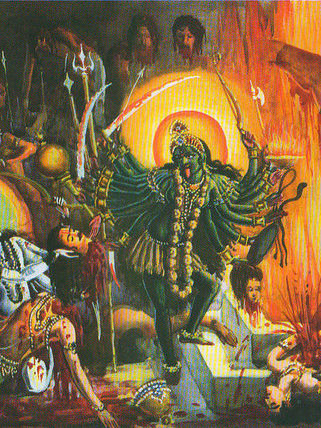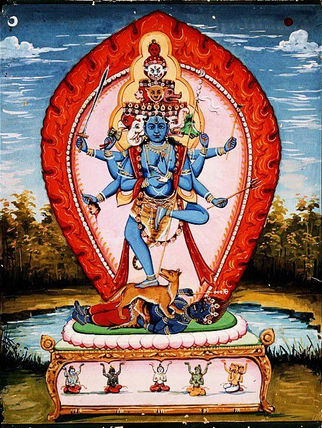
Kali
Kali is the goddess of time, birth, and death, representing the eternal cycle of creation, preservation, and distruction. She embodies both the nurturing and destructive aspects of the divine feminine and is one of the most notable deities in Hinduism, she is also associated with the Vedic name of the fire, known as Kali (all-consuming). She is regarded as the most powerful and fearsome aspect of Shakti or Durga and has a frightening appearance recognized by her long lolling tongue and black complexion. Goddess Kali is also considered to be the supreme goddess in various Tantric traditions across India.
Kali is usually shown standing or dancing on Shiva’s laying beneath her. She is always depicted in a black or dark blue complexion with long unkempt hair, ornamented with severed arms on her waist and a garland of severed human heads or skulls, called mundamala. Kali is worshipped in various forms in different traditions, and other than her fearsome iconography, she is also depicted as a calm and motherly goddess in some depictions.
Major Forms of Kali
Dakshina Kali
She is the most popular form of Kali worshipped as a household deity in Bengali tradition. She is represented as a generous mother, who protects her devotees. She is depicted with four arms, carrying a sacrificial sword and served head, two right hands in Abhaya and Varada mudra, and her right foot on Shiva’s chest.
Samhara/Vama Kali
She is a fearsome form of Kali, represented by her left foot on Shiva’s chest. She is worshipped in tantric tradition and is regarded as the representation of. death and liberation. She has four arms, carrying a sacrificial sword and served head or a plate to collect the dripping blood, and the two right hands in Abhaya and Varada mudra. She is usually worshipped in the Tantric tradition.
Mahakali
She is the highest form of Kali and a personification of reality and cosmic order. She is depicted with ten heads, ten feet, and ten arms, carrying various attributes which vary in different accounts. She is also shown with a single head, called Ekamukhi Mahakali. She is also described as the Yoganidra of Vishnu. (Read: Parashakti)
Bhadrakali
She is a fierce form of Shakti or Kali herself worshipped in various forms. She is mostly depicted with three eyes, protruding tusk, multiple hands, and flames emerging from her head. Some of her icons in South Indian temples portray her motherly nature while others as a fierce deity.
-
Dakshajit: As the consort of Virabhadra, a fearsome form of Shiva. She sprung from the anger of Shakti, who accomplished Virabhadra to destroy the sacrifice of Daksha, hence called Dakshajit. She is mostly worshipped in South India as a guardian deity. She is depicted with three eyes, and four to eighteen hands, carrying various weapons. Unlike other forms of Kali, she is not shown standing on Shiva. She is also called Rudrakali, which means the one who roars.
-
Darikajit: In Kerala, Bhadrakali is also known as Darikajit, the slayer of Darika, a demon. She is depicted mounted on a betal (ghost or ghoul) and slaying Darika.
-
Rurujit: According to the Varaha Purana, she is a form of Parvati or Bhadrakali who slayed the demon Ruru. Ruru wanted to marry Parvati but she arrived in a horrific form to him and slayed him. Rurujit is described as wearing the lion’s hide and hair smeared with the blood of a lion.
-
Mahishajit: According to Kalika Purana, Bhadrakali appeared during the Treta Yuga to defeat Mahishasuras. This form is revered as Mahishajit.
Adya Kali
She is the form of Kali, depicted as the mother of the universe. Her consort is Shiva as Adinath.
Ghuya Kali
Her name means the secret one. She is called the ultimate form of Kali, who creates, sustains, and destroys the universe. Her iconography is very distinguishable from other forms of Kali. She is shown with hundreds to-one faces. The 10-faced form of Guhyakali has twenty-seven eyes, with some faces having two, and the other having three eyes. Each of her faces represents a different animal like a leopard, lion, jackal, monkey, bear, crocodile, elephant, and horse, and they all are of a different color.
Aghor Kali
She is a form of Kali worshipped by Aghori, ascetic Shaiva sadhus. She is depicted with two arms holding a trident.
Other Forms of Kali
Virya Kali: She is an esoteric form of Kali. She has six faces and twelve hands, holding a noose, ting, severed head, sword, shield, trident, vajra, tambourine, skullcap, knife, heart, and elephant skin. She is adorned with Mundamala and severed limbs, and flames come out of her hair.
Mundamardini Kali: She is a furious form of Kali often depicted with her foot over a severed head.
Kamakala Kali: She is a furious form of Kali. She is depicted with a long lolling tongue and visible fangs. She has sixteen arms and her three eyes are red as a burning flame. She is often shown with her consort, Saghar Bhavarava.
Raksha Kali: She is who protects against epidemics. She is depicted with two arms, a blue complexion, and her left foot on the chest of Shiva, without a garland of skulls.
Samshana Kali: She is the form of Kali, who resides in the cremation ground. She is depicted with two hands holding a severed head and a bowl of blood.
Mrityunashini Rakshakali: This form of Kali is popularly worshipped in Bengali Tradition. She is depicted in a white complexion and has three heads, each having three eyes. She had six hands, carrying a sword, Amrit, Kartika (flaying knife), goad, Damru, and Chakra (disc). She keeps her right foot on Shiva while the left one is on Yama.
Rajavallabhi: She is a less common form of the goddess Kali. She is depicted with white skin and wears a necklace of demon skulls. In her right hand, she carries a sharp knife, and in her left, a bowl filled with blood. She stands with her right foot on Shiva, and her left foot on the head of a form of Bhairava, known as Siddha or Virupaksha.
Kalasamkarsani Kali: She is a furious form and the destroyer of time. She is depicted with ten arms and five faces of different colors, the one facing the worshiper being black.
Trintra Kali: She is the form of Kali, as a mother. She is depicted wearing a crescent moon on her forehead and holding Shiva as an infant child.
Bipra/ Kumari Kali: She is a child manifestation of Kali, who killed Kolasur, a demon.
Siddhi Kali: She is a form of Kali associated with accomplishment and attainment.
10. Dambara Kali
11. Indivara Kali
12. Dhandakalika
13. Ramana Kalika
14. Isana Kalika
15. Jiva Kali
16. Prajna Kali
17. Saptarna Kali
18. Bhima
19. Korangi
20. Kubjika
21. Dharmastaka
22. Dhana Kali
23. Chand Kali
24. Kaal Kali
25. Chamunda
Some other forms of Kali found in various texts are:
1. Chintamani Kali
2. Sparshmani Kali
3. Santatiprada Kali
4. Hans Kali
5. Srsti-Kali
6. Sthiti-Kali
7. Rakta Kali
8. Mrtyu Kali
9. Candogra Kali
Forms of Kali mentioned in a group
Forms of Kali in Mahakala Samhita
A Tantric text from the 10th century called the Mahakala Samhita is about the goddess Mahakali. The primary goddess of the entire tantric system, which is based on Vamacara practices, manifests as 51 different female forms. The Nine major forms of Kali mentioned in Mahakala Samhita are Dakshina Kali, Bhadra Kali, Smasana Kali, Kala Kali, Guhya Kali, Kamkalaa Kali, Dhana Kali, Chand Kali, and Siddhi Kali.
Seven Forms of Kali in Cidgaganacandrika
The Cidgaganacandrika is a Tantric text written by Kalidasa that is a part of the Kashmir Shaivism Krama system. The text mentions seven forms of Kali. They are Srsti Kali, Sthiti Kali, Samhara Kali, Rakta kali, Mrtyu Kali, Candogra Kali and Kalasamkarsani Kali.
Ashtakali
Eight forms of Kali commonly mentioned in various tantric texts are Dakshina Kali, Siddhi Kali, Guhya Kali, Sri Kali, Bhadra Kali, Chamunda Kali, Smasana Kali, and Mahakali. Another list names Chintamani Kali, Sparshmani Kali, Santatiprada Kali, Sidhidida Kali, Dakshina Kali, Kamakala Kali, Hans Kali, and Guhya Kali.
Five Forms of Kali in Kalika Puran
Five forms of Kali mentioned in Kalika Puran, one of the eighteen minor Puranas in Shaktism, are Ugracanda, Durga, Bhadrakali, Yognidra, and Parvati.
Mahavidya
Mahavidya is a group of ten Tantric goddesses, often considered the manifestations of Kali. Each of them represents a distinct principle of existence and a path of self-realization. The ten goddesses in this group are Kali, Tara, Tripura Sundari, Bhuvaneshvari, Bhairavi, Chhinnamasta, Dhumavati, Bagalamukhi, Matangi, and Kamala, led by goddess Kali herself. The Guhyati Guyha-tantra connects the ten goddesses with the ten incarnations of Vishnu, where the incarnations of Vishnu arose from the Mahavidyas. (Read: Mahavidya)
NityaKali
Goddess Kali also has fifteen Nitya who are associated with the waning of the Moon rather than the waxing of the Moon. Unlike Lalita Nitya Devis, the Kali Nitya Devis are obscure and forbidding. All these 15 goddesses are the forms or different aspects of Kali. (Read: Nitya Devis)











